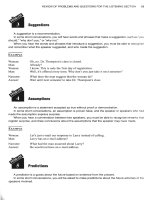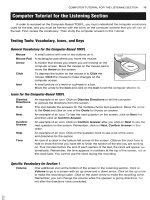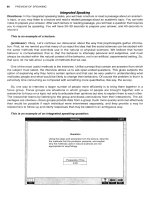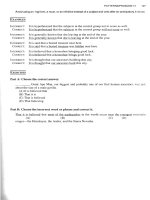Tài liệu How to prepare for the toefl part 67 docx
Bạn đang xem bản rút gọn của tài liệu. Xem và tải ngay bản đầy đủ của tài liệu tại đây (669.12 KB, 10 trang )
MODEL TEST 9 NEXT GENERATION TOEFL
663
Man:
Woman:
Man:
Woman:
Man:
Woman:
Man:
Woman:
So, is that why you decided to go into library science? Because of the tests and every-
thing?
In part. But, mostly it was because of the internship. You see, I also got my internship
through the Office of Career Development. And when
I
was working as an intern
in
the
public library, it all sort of came together for me. I really liked what I was doing, and
I
realized that I didn't want the internship to end.
And you get paid for working there in the library too, don't you?
I get paid, and I get credit toward my degree. But even better,
I
have a job offer
from
the
library where I'm doing my internship.
Wow! Are you going to take it?
I think so.
I
have to let them know next week. If I do take the job, I'll have to go to
graduate school to get a degree in library science, but
I
can do that part-time while
I'm
working, and I had thought about graduate school anyway. So, I'm leaning toward
taking the job.
That's great, Anne. I'm glad for you. So uh I guess
I'd
better make an appointment with
Ruth Jackson. Maybe she can find me an internship.
Maybe.
I
Now get ready to answer the questions. You may use your notes.
1
Audio
1.
What are the students mainly discussing?
Answer
(B)
Because the woman shares her positive experience at the Office of Career Development and
recommends career counseling to the man, it may be concluded that the main topic is the advantages
of career counseling for the man. Choices (A) and (C) are mentioned in reference to the main topic,
"the advantages of career counseling for the man." Clioice (D) is not mentioned and may not be
concluded from information in the conversation.
Audio
2.
What is the man's problem?
Answer
(C)
"I wish
I
were as sure about my future as you seem to be. I
. .
.
I really don't know what
I
want
to do after I graduate." Choice (A) is not correct because it is a concern that the man expresses when
the woman suggests career counseling, but it is not the main problem that the man brings up at the
beginning of the conversation. Choice (B) is not correct because the internship is an idea that occurs
to him after he hears about the woman's internship. Choice
(D)
is not mentioned and may not
be
concluded from information in the conversation.
Audio
3.
Why does the woman tell the man about her experience?
Answer
(A)
Because the woman's experience at the Office of Career Development was positive, it may be
concluded that she told the man about it in order to demonstrate the benefits. Choice
(B)
is not cor-
rect because the woman encourages the man to talk to a counselor about a career choice, not an in-
ternship. Choice (C) is not correct because the woman does not suggest that the man change his
major to library science, the major field that she is pursuing. Choice (D) is not correct because the
man has not made a career decision.
664
EXPLANATORY ANSWERS AND AUDIO SCRIPTS
Audw
4.
What is the woman's attitude toward her internship?
Answer
(C)
"I really liked what
I
was doing, and I realized that I didn't want the internship to 'end." Because
the woman doesn't want the internship to end, it must be a very positive experience. Choice (A) is
not correct because she is thinking about going to graduate school part-time, but she does mention
that she would rather go to graduate school than continue her internship. Choice
(B)
is not correct
because the woman is already interning. Choice
(D)
is not correct because she does not want the in-
ternship to end.
Audio
5.
What will the man probably do?
Answer
(B)
"So uh I guess I'd better make an appointment with Ruth Jackson." Choice (A) is not correct be-
cause Ruth Jackson is a career counselor at the Office of Career Development, not an academic ad-
visor. Choices (C) and
(D)
are not mentioned and may not be concluded from information in the
.
conversation.
Independent Listening
2:
"Admission"
Audio Conversation
Narrator:
Now get ready to listen to a conversation and take notes about it.
Listen to a conversation on campus between a student and an admissions officer.
Student:
Assistant:
Student:
Assistant:
Student:
Assistant:
Student:
Assistant:
Student:
Assistant:
Student:
Excuse me, but
the
secretary referred me to your office.
Yes?
I'm a new student
. . .
well, actually, I'm not enrolled yet, but I'm trying to get all my
admissions applications turned in today.
What's your name?
Robert Franklin.
Middle initial?
T.
Oh, I see. Wait a minute and we'll see what you have to do.
.
.
.
Well, according to the
records here, you have your admissions form, a financial aid application, three letters
of
recommendation, transcripts from Regional College
. . .
so that's everything you need
except a transcript from County Community College.
That's what
I
thought. You see, I took a couple of courses there during the summer be-
cause it's close to my parent's house. Anyway, almost all of my first two years is from
Regional College, and uh that's where I'm transferring from. In fact, the credit for the
community college courses appears on the transcript from Regional College as transfer
credit, but uh it doesn't show my final grades in the courses.
Oh, and you haven't been able to register for your courses here at State University be-
cause the computer shows that you are missing some of your application materials. Is
that it?
Exactly. What I was wondering is whether you have like a policy for this kind of situa-
tion so
I
could go ahead and register for this first semester while we wait for the tran-
script to get here. It should be here now. I requested it the same time that I requested
a
transcript from Regional College, but they're just slow at County Community.
MODEL
TEST
9-NEXT
GENERATION TOEFL
665
Assistant:
Student:
Assistant:
Student:
Assistant:
Student:
Assistant:
Student:
Assistant:
Student:
Assistant:
That happens sometimes.
.
. .
Do you have a copy of your transcript from County Com-
munity College?
Yes, I do. It's right here. Of course, it isn't an official copy. It's stamped "unofficial
copy."
But I can use this one until the official copy gets here. Here's the best way to handle
this. We can give you a provisional admission. That means that you're admitted contin-
gent upon the receipt of your official transcript. That will allow you to register for your
courses this semester. When County Community College sends us your official tran-
script, then
I
can change your status from provisional admission to regular admission.
Oh, that's great!
Is this the only copy you have of your transcript?
No.
I
have another one.
Good. Then I'll just keep this in your file.
Okay.
Now the only problem is you can't register for next semester without regular admission
status, and you need the official transcript for me to do that, so you still need to keep
after them to get everything sent to us as soon as possible.
Right. Well, I'll do that. But at least
I
have some time to get it done.
.
.
.
Um
.
. .
what
do
I need to do now
. . .
to get registered, I mean.
Just wait here while
I
enter everything into the computer, and then you can take a copy
of your provisional admission along with you to the Office for Transfer Students.
They'll assign you an advisor and help you get registered later today.
I
Now get ready to answer the questions. You may use your notes.
1
Audio
Why does the student go to
the
admissions office?
Answer
(D)
". .
.
I'm not enrolled yet, but I'm trying to get all my admissions applications turned in today."
Choice (A) is not correct because his financial aid form is already on file. Choice
(B)
is not correct
because he has requested an official transcript from another college to include in his admissions ap-
plications. Choice (C) is not correct because he is transferring from another college, not to another
college.
Audio
7.
What is missing from the student's file?
Answer
(B)
"
.
.
so that's everything you need except a transcript from County Community College." Choice
(A) is not correct because the woman confirms that the financial aid application is already on file.
Choice (C) is not correct because the grades from Regional College would be on the transcript that
is in the man's file. Choice
(D)
is not correct because the admissions form is the official copy of the
application.
Audio
8.
Listen again to part of the conversation. Then answer the question.
"Oh, and you haven't been able to register for your courses here at State University because the
computer shows that you are missing some of your application materials. Is that it?"
Why does the woman say, "Is that it?"
666
EXPLANATORY ANSWERS AND AUDIO SCRIPTS
Answer
(B) The woman paraphrases the problem and then asks for confirmation that she has understood.
Is
that
it
means "Is that your problem?" Choice (A) is not correct because the woman has already para-
phrased the situation. Choice (C) is not correct because the woman's tone is helpful, not impatient.
Choice (D) is not correct because the man has explained a problem but he has not asked a question yet.
Audio
9.
What does the woman suggest that the man do?
Answer
(D)
".
. .
you still need to keep after them to get everything [the official transcript from County
Community College] sent to us as soon as possible." Choice (A) is not correct because he already
has an unofficial copy of his transcripts. Choice
(B)
is not correct because, according to their
records, the admission form is already on file. Choice (C) is not correct because he must have his
official transcript before he can change his provisional status to regular status next semester and
because he will register this semester with provisional status.
Audio
10. What will the student most probably do now?
Answer
(B) " you can take a copy of your provisional admission along with you to the Office for Transfer
Students. They'll assign you an advisor and help you get registered.
. . .
"
Choice (A) is not correct
because the man will see an advisor, not the woman, later today. Choice (C) is not correct because it
refers to what the woman, not the man, will do. Choice (D) is not correct because the woman is as-
signing the provisional status to the man without her superior's approval.
Independent
1
istening
3:
"Groups"
Audio Lecture
Narrator:
Now get ready to listen to a lecture and take notes about it.
Listen to part of a lecture in a sociology class.
Professor:
Social influence involves the changes in behavior influenced by the actions of other people. Social
influence can come about for a variety of reasons, on a continuum from mere suggestion to, in the
more severe form, well, to torture. How does social influence work? Well, first we must become
aware of a difference between ourselves and the values or behaviors of other people. There are
a
great many studies of social influence that demonstrate how the presence of others can cause us to
change our attitudes or actions. Studies show that people eat more when dining with others than, and
I'm
talking about dining out here, so they eat more in the company of others than they do when
they're alone. They also run faster when others are running with them. There's even some interesting
research on social influence among animals with similar results to
. . .
to those of human studies.
Probably one of the most interesting aspects of social influence is the pressure for conformity. Con-
formity is a process by which an individual's opinion or behavior moves toward the norms of the
group. In a classic study by Solomon Asch, seven people were shown cards with three lines drawn
on them. Here's an example:
MODEL TEST 9-NEXT GENERATION TOEFL
667
123
Standard Comparison
Line Lines
So, they were shown the lines, and then they were asked to select the line among the three that
matched the uh
. .
.
the uh
.
.
.
standard line. Here's the standard. So there's no question as to the
comparison. This has to be easy, right? Wrong. You see, Asch enlisted the cooperation of six of the
seven participants in the experiment. On the first card, the six respond correctly-they
.
.
.
they
identify the lines of the same length-so the seventh person, who is the only real subject in the ex-
periment, well, the seventh person answers correctly, in agreement with the others. But on the next
card, four of the cooperating participants choose an incorrect answer, but they're in agreement,
so
the problem for the subject is whether to conform to the opinion of the peer group, even though the
answer um
.
. .
is in conflict with the answer that the subject knows to be correct.
So what do you think happened? Well, subjects who were tested alone made errors in answers
fewer
than
1
percent of the time. This was the control group. But of those tested in groups of seven, let's see
um,
75
percent yielded at least once to conform to a group answer that was clearly incorrect, and on
average, subjects conformed to the group in about
37
percent of the critical trials. This means that they
were bringing their behavior into agreement with group norms in.
. .
in spite of what they were seeing.
Later Asch manipulated the size of the control group.
. .
I'm sorry, the experimental group
. . .
to see
whether group size would affect pressure, and it did, but probably less than you might expect.
Um
. . .
groups of four demonstrated about the same results as groups of eight. Interestingly enough,
a unanimous agreement by the group was more important than the number. In other words,
a
unan-
imous opinion by three exerted more pressure to conform than a majority of seven with a dissenting
opinion in a group of eight.
Similar experiments have been performed in various countries, among diverse cultural groups, with
um comparable results. Of course, people in cultures that emphasize group cooperation tended to be
more willing to conform, but remember that many of the original studies were done in the United
States where there's a high value placed on individualism. In an interesting variation on the study,
Abrams found that conformity is especially strong when the group is selected from among those
people that the subject clearly identifies with, either because, um .they have characteristics in com-
mon or.
. .
or they know each other and interact in a peer group outside of the experimental situation.
So what does all of this mean in the real world? Well, since group members can influence one an-
other to conform to the opinion of the group, the group
. . .
decisions of
a
group uh may be called
into question. What about decisions by political committees or parliaments? What about juries who
are charged with convicting or acquitting an accused defendant? Clearly, social influence will play
a part in these critical group decisions.
668
EXPLANATORY ANSWERS AND ALIDIO SCRIPTS
Also interesting is the fact that after a decision is made by a group, there's a tendency to solidify,
and by that
I
mean that the group becomes even more convinced of the validity of the group opin-
ion. Um
. .
.
this may happen because individual group members who strongly support the group
tend to be more popular with the group members.
I
Now get ready to answer the questions. You may use your notes.
I
Audio
11. What is the main topic of the talk?
Ansiver
(C) "Social influence involves the changes in behavior influenced by the actions of other people."
Choices (A), (B), and
(D)
are all mentioned as secondary topics that are used to develop the main
topic of the lecture, "the influence of groups on individual behavior."
Audio
12.
According to the professor, what two results were reported in the Asch and Abrams studies?
Answer
(B)
(C)
".
. .
subjects conformed to the group in about
37
percent of the critical trials.
. . .
Abrams
found that conformity is especially strong when the group is selected from among those people
.
.
.
[who] interact in a peer group outside of the experimental situation." Choice (A) is not correct be-
cause a larger group of eight demonstrated about the same results as a smaller group of four. Choice
(D) is not correct because a unanimous opinion by three exerted more pressure to conform than a
majority of seven with
a
dissenting opinion in a group of eight.
Audio
13.
Listen again to part of the lecture. Then answer the question.
"Later Asch manipulated the size of the control group
.
.
.
I'm
sorry
.
.
.
the experimental group.
.
.
to see whether group size would affect pressure, and it did, but probably less than you might
expect."
Why does the professor say this: "I'm sorry
.
.
.
the experimental group
. . ."
Answer
(C) Professors occasionally misspeak and must correct themselves. The professor is talking about
the experimental group, and incorrectly refers to the control group. Choice (D) is not correct be-
cause she is providing the facts in logical sequence. She is not returning to a previous point in the
lecture to add important facts. Choices
(A)
and (B) are not mentioned and may not be concluded
from information in the lecture.
Audio
14.
What generally happens after a group makes a decision?
Answer
(C)
". .
.
after a decision is made by a group, there's a tendency to solidify
. . .
the group becomes
even more convinced of the validity of the group opinion." Choice
(D)
refers to the fact that those
who support the group most strongly tend to be more popular with the group, but competition for
leadership is not mentioned and may not be concluded from information in the lecture. Choices
(A)
and (B) are not mentioned and may not be concluded from information in the lecture.
MODEL
TEST
9-NEXT GENERATION
TOEFL
669
Audio
15.
Based on information in the lecture, indicate whether the statements describe the Asch study. For
each sentence, click in the YES or
NO
column.
Answer
(A)
is YES.
".
.
.
the seventh person
.
. .
is the only real subject in the experiment.
.
.
.
"
(B)
is
NO.
".
. .
there's no question as to the comparison."
(C)
is YES.
"
.
. .
Asch enlisted the cooperation of
six of the seven participants in the experiment."
Independent Listening
4:
"Photography"
Audio
Lecture
Narrator: Now get ready to listen to a lecture and take notes about it.
Listen to part of a lecture in an art history class.
Professor:
We know that the Chinese had been aware of basic photographic principles as early as the fifth
century
B.c.,
and Leonardo da Vinci had experimented with a dark room in the 1500s, but it was
a number of discoveries in chemistry during the eighteenth century that uh
. .
.
accelerated the
development of modem photography. The discovery that silver salts were light sensitive led to
.
.
.
experimentation with images of light on a.
.
.
a surface that had been coated with silver. Often glass
was used in the early images. But the problem was that these images were ephemeral-fading after
only a short time. Some of the chemists who worked with them called them fairy pictures, and con-
sidered them uh
.
.
.
that they were only moment& creations uh
. . .
that they would disappear.
Okay. How to fix the image permanently was one of the most important uh
. .
.
challenges
. . .
of the
early photographer chemists. In France, in about
1820,
Nicephore Niepce discovered a method for
fixing the image after a long exposure time, oh, probably eight hours. So, although his work was
considered interesting, it was uh
.
.
.
uh
. .
.
largely dismissed for
.
.
.
as impractical. Nevertheless,
one of his associates, Louis Daguerre, managed to find a way to uh
.
. .
reduce.
. .
the exposure time
to less than twenty minutes. So the story goes, in
1835,
Daguerre was experimenting with some ex-
posed plates, and he put a couple of them into his chemical cupboard, so a few days later, he opened
the cupboard, and uh
. .
.
to his surprise, the latent images on the plates had developed. At first,
he
couldn't figure out why, but eventually, he concluded that this must have occurred as a result of
mercury vapor.
.
.
from a broken thermometer that was also in the
.
. .
uh
.
.
.
enclosed in the cup-
board. Supposedly, from this fortunate accident, he was able to invent a process for developing la-
tent images on
.
.
.
on exposed plates.
The process itself was somewhat complicated. First, he exposed copper plates to iodine which re-
leased fumes of uh
.
.
.
of light-sensitive silver iodide. These copper plates were used to capture the
image, and by the way, they had to be used almost immediately after their exposure to the iodine.
So, the image on the plate was then exposed to light for ten to twenty minutes. The plate was devel-
oped over mercury heated to about
75
degrees centigrade, which
. .
.
that caused the mercury to
amalgamate with the silver. Now here's the ingenious part-he then fixed the image in a warm so-
lution of common salt, but later he began using sodium sulphite. Anyway, after he rinsed the plate
in hot distilled water, a white image was left permanently on the plate. And the quality was really
quite amazing.
But, um
. . .
the process had its limitations. First, the images couldn't be reproduced, so each one
was a unique piece, and that uh greatly increased the cost of photography. Second, the image was
reversed, so the subjects would actually see themselves as though they were looking in a mirror,
670
EXPLANATORY ANSWERS AND AUDIO
SCRIPTS
although, uh
.
.
.
in the case of portraits, the fact that people were accustomed to seeing themselves
in a mirror made this less
. .
.
this problem less urgent than some of the others. Nevertheless, some
photographers did point their cameras at a mirrored reflection of the image that they wanted to cap-
ture so that the reflection would be reversed, and a true image could be produced. Okay. Third, the
chemicals and the fumes that they released were highly toxic, so photography was a very dangerous
occupation. Fourth, the surface of the image was extremely fragile and .had to be protected, often
under glass, so they didn't disintegrate from being
. .
.
from handling. The beautiful cases that were
made to hold the early images became popular not only for aesthetic purposes but uh
.
. .
but also for
vev practical reasons. And finally, although the exposure time had been radically reduced, it was
still
.
.
.
inconveniently long
. .
.
at twenty minutes, especially for portraits, since people would have
to sit still in the sun for that length of time. Elaborate headrests were constructed to keep the sub-
jects from moving so that the image wouldn't be ruined, and uh
.
. .
many people simply
didn't want to endure the discomfort.
But, by the mid 1800s, improvements in chemistry and optics had resolved most of these issues.
Bromide as well as iodine sensitized the plates, and some photographers were even using chlorine
in an effort to decrease exposure time. The
. .
.
the portrait lens was also improved by reducing the
size of the opening, and limiting the amount of light that could enter, so the exposure time was about
twenty seconds instead of twenty minutes. And negative film had been introduced in France, sorry,
in England, and negatives permitted the production of multiple copies from a single image. So,
photography was on its way to becoming a popular profession and pastime.
-
Now get ready to answer the questions. You may use your notes.
Audio
16.
What is the main topic of this lecture?
Answer
(D)
The lecture begins with historical background information and then focuses on the history of
early photography in the 1800s when it was evolving into modem photography. Choices (A), (B),
and (C) are all mentioned as secondary topics that are used to develop the main topic of the lecture,
"the history of early photography."
Audio
17. According to the professor, what two limitations were noted in Daguerre's process for developing
and fixing latent images?
Answer
(B)
(C)
"But
. .
.
the process had its limitations. First, the images couldn't be reproduced, so each
one was a unique piece.
.
.
.
Fourth, the surfaces of the image were extremely fragile and
. .
.
had to
be protected
.
. .
so they didn't disintegrate
. .
.
from handling." Choice (A) is not correct because
Daguerre had resolved the problem of fixing the image in his process. Choice (D) is not correct
because Daguerre's process had reduced the exposure time to twenty minutes.
Audio
18. Listen again to part of the lecture. Then answer the question.
"At first, he couldn't figure out why,
.
.
.
but eventually, he concluded that this must have occurred
as a result of mercury vapor from a broken thermometer that was also in the uh
. . .
enclosed in the
cupboard. Supposedly, from this fortunate accident, he was able to invent a process for developing
latent images on
. .
.
on exposed plates."
MODEL TEST 9-NEXT GENERATION TOEFL
671
Why does the professor say this:
"Supposedly, from this fortunate accident, he was able to invent a process for developing latent
images on
.
. .
on exposed plates."
Answer
(C)
The word
supposedly
implies that the speaker is not sure about the information. Choice
(A)
is
not correct because she would not use such a neutral tone if she were trying to draw students into the
story. Choice
(D)
is not correct because she does not invite them to use their imaginations while she
is recounting the story. Choice (B) is,not correct because the origin of the story is not mentioned.
Audio
19.
What substance was first used to fix the images?
Answer
(B)
"Now here's the ingenious part-he then fixed the image in a warm solution of common
salt.
.
.
.
"
Choice (A) is not correct because copper was the substance used for sensitizing the plates,
not for fixing the images. Choice
(C)
is not correct because mercury vapor was the substance used
to develop the plates, not to fix the images. Choice
(D)
is not correct because hot water was the sub-
stance used to rinse the plates after the images were fixed.
Audio
20. What can we assume about photographers in the 1800s?
Answer
(D)
Because "the chemicals and the fumes that they released were highly toxic" and photography
was "a very dangerous occupation," it may be concluded that some photographers must have expe-
rienced health problems as a result of their laboratory work. Choice
(B)
is not correct because many
people didn't want to endure the discomfort associated with sitting still for a long time in order to
have
a
portrait done. Choices (A) and
(C)
are not mentioned and may not be concluded from infor-
mation in the lecture.
Independent Listening
5:
"Mhority"
Audw Lecture
Narrator: Now get ready to listen to a lecture and take notes about
it.
Listen to part of a lecture in an anthropology class.
Professor:
The concepts of power and authority are related, but they're not the same. Power is the ability to
exercise influence
.
.
.
and control over others. And this can be observed on every level of society,
from, well
.
.
.
the relationships within a family to the relationships among nations. Power is usual-
ly structured by customs and
. . .
and social institutions or laws and tends to be exerted by persua-
sive arguments or coercion or
.
. .
or even brute force. In general, groups with the greatest uh
.
.
.
resources tend to have the advantage in power struggles. So, is power always legitimate?
Is
it
viewed by members of society as justified? Well, no. Power can be realized by individuals or groups
. . .
even when it involves the resistance of others if.
.
.
as long as
.
. .
as long as they're in a position
to impose their will. But what about power that is accepted by members of society as right and just,
that is, legitimate power? Now we're talking about authority. And that is what
I
want to focus on
today.
672
EXPLANATORY ANSWERS AND AUDIO SCRIPTS
Okay. When individuals or institutions possess authority, they have um
. .
.
a recognized and estab-
lished right
. . .
to determine policies, with the acceptance of those over
.
. .
over
. . .
whom they
exercise control. Max Weber, the German classical sociologist, proposed three types of authority in
society: traditional, charismatic, and rational or legal authority. In all three types, he uh
.
. .
he
acknowledged the right of those in positions of power to lead
. .
.
with the consent of the governed.
So, how did Weber differentiate among the three types of authority? Well, he divided them accord-
ing to how the right to lead and the duty to follow are uh interpreted. In traditional authority, power
resides in customs and conventions that provide certain people or groups with legitimate power in
their societies. Often their origin is found in sacred traditions. The example that most often comes to
mind is a monarchy in which kings or queens rule
. .
.
uh
.
. .
by birthright, not because of any
particular
.
.
.
quality of leadership or political election, just because they have a claim to authority,
based on traditional acceptance of their position, and in some cases, their uh their uh
. . .
unique re-
lationship with and uh responsibility in religious practices. The royal families in Europe or the
emperors in Asia are
.
. .
come to mind as examples of traditional authority.
Okay. This contrasts sharply with charismatic authority, which is
. . .
uh
.
. .
derived
.
. .
because of
,personal attributes that inspire admiration, loyalty, and
. . .
and even devotion. Leaders who exercise
this type of authority may be the founders of religious movements or political parties, but it's
'not their traditional right to lead. What's important here is that their followers are mobilized more
by
. .
.
by the force of the leader's personality than by the tradition or the law. So when we think
of
"charismatic" leaders in the United States, perhaps John Kennedy would be an example because he
was able to project a youthful and energetic image that people were proud to identify with, or, if you
prefer Republicans, you may argue that Ronald Reagan was able to exercise authority by virtue of
his charismatic appeal. In any case, going back to Weber, to qualify for charismatic authority, a
leader must be able to enlist others in the service of a
. . .
a cause that transforms the social structure
in some way.
Which leaves us with legal rational authority, or power that is legitimized by rules, uh laws, and pro-
cedures. In such a system. leaders gain authority not by traditional birthrights or by charismatic ap-
peal but
. .
.
but rather because they're elected or appointed in accordance with the law, and power
is delegated to layers of officials who owe their allegiance to the uh
.
.
.
principles that are agreed
upon rationally, and because they.accept the ideal that the law is supreme. In a legal rational society,
people accept the legitimacy of authority as a government of laws, not of leaders. So, an example of
this type of authority might be a president, like Richard Nixon, who was threatened with uh im-
peachment because he was perceived as not governing within the law.
Some sociologists have postulated that the three types of authority represent stages of evolution
in
society. That preindustrial societies tend to respect traditional authority, but um
. . .
as societies
move into an industrial age, the importance of tradition
. . .
wanes
.
. .
in favor of charismatic
authority, with a natural rise of charismatic leaders. Then, as
.
.
.
as the modem era evolves, the
rational legal authority, embodied by rules and regulations, replaces the loyalty to leaders in favor
of.
.
.
a respect for law. Of course, other sociologists argue that in practice, authority may be repre-
sented by a combination of several of these ideal types at any one time.
Now get ready to answer the questions. You may use your notes.









